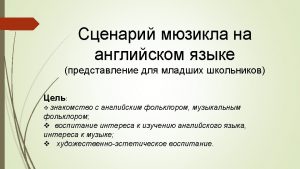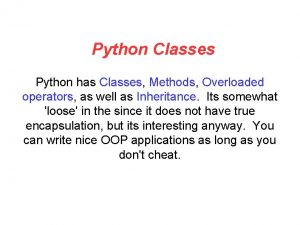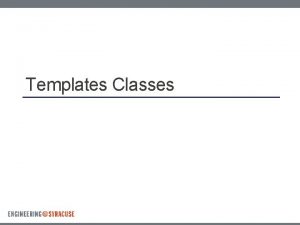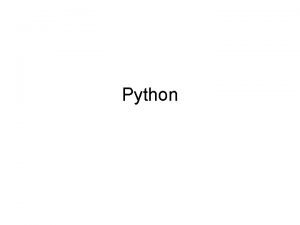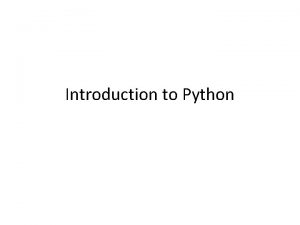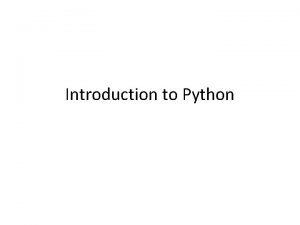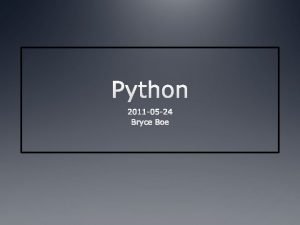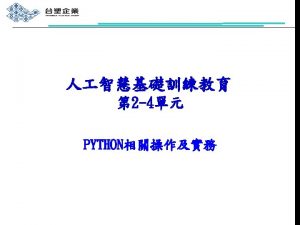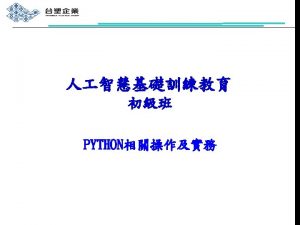Python classes new and old New and classic
















- Slides: 16

Python classes: new and old

New and classic classes · With Python 2. 2, classes and instances come in two flavors: old and new · New classes cleaned up the language by • Unifying classes and types • Allowing all built-in types to be sub-classed · For compatibility, default 2. x class is old style; Python 3 only has new classes · New classes support interesting features · New classes subclass object

New class student class Student(object): “““A new class representing a student””” def __init__(self, n, a): self. full_name = n self. age = a def get_age(self): return self. age

Class property · One neat feature in new classes is the property function · It’s a better way to manage private attributes, and getter and setter methods · While still keeping access simple · We’ll also see decorators, an interesting feature

Boxes, little boxes class Box(object): def __repr__(self): return ”<A box with length: %s, width: %s, area: %s>" % (self. length, self. width, self. area) class Box 1(Box): """A rectangle""" def __init__(self, l=1, w=1): self. length = l self. width = w self. area = l * w http: //cs. umbc. edu/courses/331/current/code/python/box. py

Boxes, little boxes · Ok, but not perfect >>> from box import * >>> b 1 = Box 1(2, 3) >>> b 1 A box with length: 2, width: 3, area: 6 >>> b 1. area = 9 >>> b 1 <A box with length: 2, width: 3, area: 9> http: //cs. umbc. edu/courses/331/current/code/python/box. py

Boxes, little boxes · Let’s use a getter method for area class Box 2(Box): """A rectangle with area getter""" def __init__(self, l=1, w=1): self. length = l self. width = w def get_area(self): return self. length * self. width def set_area(self, val=1): print "Warning: area is read only!" http: //cs. umbc. edu/courses/331/current/code/python/box. py

Boxes, little boxes · Not without problems, though… >>> from box import * >>> b 2 = Box 2(2, 3) >>> b 2 Traceback (most recent call last): File "<stdin>", line 1, in <module> File "box. py", line 5, in __repr__ return "<A box with length: %s, width: %s, area: %s>" % (self. length, self. width, self. area) Attribute. Error: 'Box 2' object has no attribute 'area’ http: //cs. umbc. edu/courses/331/current/code/python/box. py

Boxes, little boxes · There are two problems that the getter/setter idiom creates · It results in different access patterns for different attributes · If we start with plain attributes and later decide to use getter and setters, we may have a lot of code to change http: //cs. umbc. edu/courses/331/current/code/python/box. py

Boxes, little boxes · Python solution: property() class Box 3(Box): """A rectangle with area property""" def __init__(self, l=1, w=1): self. length = l self. width = w def get_area(self): return self. length * self. width def set_area(self, val=1): print "Warning: area is read only!" area = property(get_area, set_area) http: //cs. umbc. edu/courses/331/current/code/python/box. py

Boxes, little boxes · The property() function takes optional args for an attribute’s getter, setter, deleter and doc string property([fget[, fset[, fdel[, doc]]]]) · and returns an object · Not providing a setter results in a readonly attribute http: //cs. umbc. edu/courses/331/current/code/python/box. py

Decorated Boxes · Use Python decorators class Box 4(Box): """A rectangle with area property""" def __init__(self, l=1, w=1): self. length = l self. width = w @property def area(self): return self. length * self. width @area. setter def area(self, val=1): print "Warning: area is read only!” http: //cs. umbc. edu/courses/331/current/code/python/box. py

Python Decorators · Python’s decorator is syntactic sugar @foo def bar (x): pass · Is the equivalent of def bar (x): pass bar = foo(bar) · That is: rebind the name bar to the result of calling foo with the function object bar · foo typically returns a modified version of the function bar

Decorator example: trace def trace(f): def new_f(*args) print 'Entering %s%s' % (f. __name__, args) result = f(*args, **kwargs) print 'Exiting %s%s with %s' % (f. __name__, args, result) return result return new_f >>> sum(10, 20) Entering sum(10, 20) @trace Exiting sum(10, 20) with 30 def sum(n, m): 30 return n + m http: //cs. umbc. edu/courses/331/current/code/python/trace. py

Decorator example: trace @trace def fact(n): return 1 if n<2 else n * fact(n-1) >>> fact(4) Entering fact(4, ) Entering fact(3, ) Entering fact(2, ) Entering fact(1, ) Exiting fact(1, ) with 1 Exiting fact(2, ) with 2 Exiting fact(3, ) with 6 Exiting fact(4, ) with 24 24

class Box 5(Box): def __init__(self, l=1, w=1): self. length = l self. width = w self. _color = None @property def area(self): return self. length * self. width @area. setter def area(self, val=1): self. length = self. width = math. sqrt(val) @property def color(self): return self. _color @color. setter def color(self, val): self. _color = val @color. deleter def color(self): del self. _color Decorated Boxes
 Classes e subclasses das palavras
Classes e subclasses das palavras Pre ap classes vs regular classes
Pre ap classes vs regular classes New-old approach to creating new ventures
New-old approach to creating new ventures New years old is new again
New years old is new again Once upon a time there lived
Once upon a time there lived Once upon a time there lived an old man and an old woman
Once upon a time there lived an old man and an old woman And how old are you
And how old are you Hansel once upon a time
Hansel once upon a time Social classes of new spain
Social classes of new spain Difference between old covenant and new covenant
Difference between old covenant and new covenant The old way and the new way
The old way and the new way Old man and new man
Old man and new man Difference between old and new concept of marketing
Difference between old and new concept of marketing Old and new matrix algebra useful for statistics
Old and new matrix algebra useful for statistics Module 9 old and new
Module 9 old and new Old imperialism motives
Old imperialism motives Young and old prophet
Young and old prophet





